
Topics
Guests
- Yoko Onomusician, artist and peace activist. Last week she unveiled the Imagine Peace Tower in Iceland, dedicated to her late husband John Lennon.
Today, we spend the hour with Yoko Ono: artist, musician, peace activist. She joins us in the firehouse studio just days after returning from Iceland, where she unveiled a project 40 years in the making: the Imagine Peace Tower. Dedicated to her late husband John Lennon, the tower shoots light into the sky and bears the inscription “Imagine Peace.” It will light up every year between October 9th, the day of Lennon’s birth, and December 8th, the day of his death. [includes rush transcript]
Transcript
AMY GOODMAN: Today, we spend the hour with Yoko Ono, artist, musician, peace activist. She’s here in the firehouse studio with us, just days after returning from Iceland, where she unveiled a project forty years in the making: the Imagine Peace Tower. Dedicated to her late husband John Lennon, the tower shoots light into the sky and bears the inscription “Imagine Peace.” It will light up every year between October 9, the day of John Lennon’s birth, and December 8, the day of his death.
Today, we speak with Yoko Ono about this latest project and her long and sometimes overlooked career as a prolific artist and innovator. We’ll also talk about her husband, John Lennon, and how their political activism together led to government surveillance and deportation attempts from the Nixon administration. But first, this is an excerpt of Yoko Ono’s speech, unveiling the Imagine Peace Tower one week ago today.
YOKO ONO: We are here together, billions of us, standing at the dawn of a new age, determined to shift the axis of the world to health, peace and joy by loving and caring for all lives on earth.
Some of us are here physically, some are joining us in spirit. Some of us are imprisoned, tortured, maimed and silenced, but they are also here today with us. Some of us have passed away before being able to enjoy a new age of love and peace. But we are all here today, standing together with hope.
The light is the light of wisdom, healing and empowerment. Even in the moments of confusion, fear and the darkness of your souls, hold the light in your hearts, and you will know that you are not alone, that we are all together in seeing the light of peace.
AMY GOODMAN: Yoko Ono, speaking a week ago in Reykjavik, Iceland. Among those joining her to unveil the statue was Sean Lennon, her only child with John Lennon. John Lennon’s fellow Beatle, Ringo Starr, was also there. Yoko Ono joins us now in the firehouse studio for the hour. Welcome to Democracy Now! Thanks so much.
YOKO ONO: Good morning, Amy.
AMY GOODMAN: It’s great to be with you. Tell us about this monument in Iceland.
YOKO ONO: Well, about 40 years ago — I think in 1965, so it was 42 years ago — I thought of this idea of having a lighthouse, a light tower, and that only emerges when the environment and the weather and everything is right. And I just liked that concept, that there’s a tower that isn’t just staying there, but depends on the environment that it just comes out. And right now, I think, because it’s a peace tower, and it’s kind of blinking, which is very, very, I think, real and true to what’s going on now. It’s blinking in a sense that it comes out only from John’s birthday to John’s — the day that he passed away. And so, it’s a small — but, you know, it just shows how life is short, but light and the concept of light is eternal.
JUAN GONZÁLEZ: And why Iceland?
YOKO ONO: Well, the reason is because Iceland is a very, very unique country. And right now, everywhere, all different countries are suffering because of oil and the shortage of oil, and they’re fighting over oil. I mean, oil is always this sort of like — the reason to go to war, something like that. But in Iceland, 80 percent of the energy is done by geothermal, meaning water. Water is supplying the energy, instead of oil.
And it’s a very, very interesting thing that they’re doing. What happened was, in the Depression,1930s, around then, they realized that they were using coal as the energy source, and they realized that they couldn’t buy any more coal, and just the whole country would just dissipate. So they found a way at the time how to use their resources, which was the geothermal energy. And from then on, they started geothermal energy instead of oil. And so, they’re very independent from that sort of a struggle of getting oil, and it’s very beautiful.
AMY GOODMAN: So you conceived of this before John was killed? He knew about this idea?
YOKO ONO: No, he didn’t know about this idea. We didn’t know anything about this. Oh, what we knew was that I thought of building a light tower, and John loved that idea, this light tower that just emerges once in awhile. And so, he actually invited me in 1967, the first time that he invited me to his house in Kenwood, and I was wondering what it was about. I thought it was a party or something, but, no, it was a very quiet day. And he said, “Well, actually, I invited you because I wanted to know if you can build the lighthouse in my garden,” which was — and I said, “Oh, dear, no, no. It’s just a conceptual idea. I don’t know how to build anything,” and I was just laughing. But that’s when he wanted this light tower, and that was forty years ago. And now — and that was '67, and it's a very strange numerological thing, you know, because this year is his 67th birthday. And I didn’t plan it that way; it just happened, you know, this sort of — we’re having this unveiling of the lighthouse.
AMY GOODMAN: And “Imagine Peace” is written in 24 languages?
YOKO ONO: Twenty-four languages. And, you know, somebody — I’m sure somebody will come out and say, “Well, what about this language, that language?” So we have about space for another 10 languages on the wall.
AMY GOODMAN: And the response of the people of Iceland?
YOKO ONO: Oh, well, people in Iceland, I hope, and I saw this sort of — I witnessed the fact that they were all very, very happy. They were ecstatic. The reason — one of the reasons, because the winter is rather dark in Iceland, and, you know, they like the idea that there’s light in the winter.
AMY GOODMAN: We’re talking to Yoko Ono, musician, artist, peace activist, just back from Reykjavik, from Iceland, where she unveiled the Imagine Peace Tower. It’s a light tower dedicated her late husband John Lennon.
YOKO ONO: And, you know, there are many interesting things about this, surrounding this, because I think that they found out that Edgar Cayce said something about there will be a tower of light in the foremost northern country, which will spread peace to the world, something like that. I think Edgar Cayce said that. So I don’t know, you know. It seems like somehow I’m fulfilling the prediction or something. But I didn’t know that. And, you know, they told me about that in Iceland.
AMY GOODMAN: And you have a website, imaginepeace.com?
YOKO ONO: Ah, yes. Imaginepeace.com. Please, you know, click into imaginepeace.com, because it’s — then you will know all the stories about it.
JUAN GONZÁLEZ: Well, throughout your life, you’ve merged your political activism with your art.
YOKO ONO: Yes.
JUAN GONZÁLEZ: Could you talk about that and how you’ve tried to use your art to get messages out?
YOKO ONO: Well, I think that all of us, not just artists — but, well, when I say “artists,” I think people who consider themselves artists — I think that everybody, if they want to be an artist, they can be. And also we’re using this creative energy of being an artist to just fulfill what we have to do, in a sense that all of us live in this society, and we’re all responsible for what happens in society, not just the artists. And so, I’m just doing what I can do, so that’s all, you know.
But I just wanted to tell you this very interesting thing that happened, so in Toronto a couple days ago — a couple of weeks ago, that a male student was wearing a pink shirt, and he was gay, and so he was harassed and he was ostracized. And so, the next day, his friends all wore pink shirts. And this is sort of like spreading. Now there are many people who are wearing pink shirts, and other school students are asking, “Well, what can we do?” You know?
And I think that this — we’re living in a situation that there’s a lot of fear and confusion, and, you know, some people are very pessimistic about the future. But I really think that we can do it. We can survive. And, you know, it’s so natural for us to want to survive. It’s a very strong sort of instinct in us. And we are going to do it. And I see that all sorts of beautiful things are starting to happen. And they’re all writing to me at imaginepeace.com, so I’d like you to, you know, click in, and then you’ll see these things are happening.
There’s another thing that happened very recently. I don’t know if this is very recent — well, I think it is, that — well, I better read it so that it’s just sort of — I’ll be very exact about it. In September, a project was launched with the aim “at storing CO2 in Iceland’s lavas by injecting the greenhouse gas into basaltic bedrock where it literally turns to stone.” Now, “carbon dioxide turning into calcite is a well known natural process in volcanic areas and now the scientists of the University of Iceland, Columbia University [in New York] and the CNRS in Toulouse[, France,] are developing methods to imitate and speed up this transformation of the gas that is the prevalent contributor to global warming.” So they’re fighting global warming, and it’s very interesting. I saw this lava, a sort of kind of looking ugly kind of stone, and then they showed me how it was calcified into a beautiful, beautiful sort of like a crystal. And so, that’s what they’re trying to do now and lessen the global warming. So, of course, we have to do more to lessen the global warming. But that’s another way they’re trying to do it, and I think we’re going to hack it. I think we’re going to do it.
AMY GOODMAN: We’re talking to Yoko Ono. We’ll be back with her in a minute.
[break]
AMY GOODMAN: As we were playing that song [“Imagine”] for our TV viewers, Yoko Ono, we were showing images. One of them was a poster that said, “The war is over!” Explain.
YOKO ONO: Well, one day I thought, well, it’s great to say “War is over” and have all these people — well, this was the first idea, that I would have many famous people partying in Ascot House, and then somebody would just come in and say, “War is over.” And they all say, “Oh, my god, the war is over, if you want it.” But the thing is, then, you know, we decided to do it as a poster, and then John decided to do it on a billboard. And it just became “War is over! If you want it.” It was much better than having a party and then having some TV camera crew to come and film it and all that, because it was a much better idea, so we just did it that way.
AMY GOODMAN: I wanted to go for a minute to a clip of a documentary called The U.S. vs. John Lennon. It was directed by John Scheinfeld. It chronicles, well, your husband John Lennon and also Yoko Ono, their political activism around the Vietnam War and other issues of social justice in the ’60s and ’70s, and how the activism led to government surveillance and persecution of them. This clip looks at how John and Yoko spent their honeymoon by staging a week-long bed-in against the Vietnam War.
JOHN LENNON: We’re going to stay in bed for seven days, sort of, instead of having a private honeymoon. This is a private protest.
YOKO ONO: For the violence that’s going in the world, you see?
JOHN LENNON: To say that —
YOKO ONO: Be sure that instead of making war, it’s better to just stay in bed. Let’s just stay in bed for the spring.
JOHN LENNON: And grow your hair for peace. Let it grow ’til peace comes.
UNIDENTIFIED: What the press really wants is a picture of John and Yoko in bed on their honeymoon. And then they turned it around and said, “Well, in that case, let them have a picture of John and Yoko in bed their honeymoon, but put the word 'peace' in it.”
JOHN LENNON: So we’re going to make love in bed, you see, and all the press from all around the world came, and we opened the — helpers opened the door, and they’re fighting to get in there, you know, like this with their cameras. And then their faces dropped. We’re sitting like angels saying, “Hello. Peace, brother.” And all their faces dropped, and we were just in bed.
INTERVIEWER: You were wearing —
JOHN LENNON: We thought it was a great practical joke that most of the world’s headline newspapers, especially the European and British, was: “Married couple are in bed.”
DAVID FENTON: Oh, there had never been anything like it. It was completely original. The conscious use of one’s myth to project a political and social poetic goal, it never happened before.
YOKO ONO: Up to then, people who were promoting world peace were kind of like intellectual, anemic kind of people, just sort of like passing out pamphlets that nobody wants to read, you know? And so, John was saying, “No, no.” That’s why we wanted to do it this way, you know? And I think we did a great job.
JOHN LENNON: [reading] “Please stop this nonsense. Go home. We don’t like people like you. Go to a doctor to be normal.” Like, you get this?
YOKO ONO: It’s great.
JOHN LENNON: “Go to a doctor to be normal.” Well, we’re seeing a psychiatrist today, so maybe he’ll fix us up then. Bloody marvelous.
FELIX DENNIS: When people are creative geniuses, you have to cut them some slack. You really have to cut them some slack. England isn’t good at cutting slack for working-class boys.
DONALD ZEC: If it works, it’s right. If it doesn’t work, it’s wrong.
JOHN LENNON: Well, nobody has ever given it a chance before, you know, have they? Nobody has ever given peace a complete chance. Gandhi tried it, and Martin Luther King tried it. But they were shot. But nobody’s given —
DONALD ZEC: You can’t get peace in a king-sized divan on [inaudible].
JOHN LENNON: No, you can’t, but we don’t expect to. But, I mean, we’re talking mainly to the revolutionaries who think they can get it overnight by breaking down the buildings, you know?
YOKO ONO: They can’t get it done.
JOHN LENNON: They can’t get it. We thought about this for months. This is the best possible, most functional and effective way of promoting and protesting against violence that our minds combined could think of.
YOKO ONO: Yes.
AMY GOODMAN: John Lennon and Yoko Ono in their bed-in, their honeymoon, that they shared with the world. It’s from the film The U.S. vs. John Lennon. Yoko Ono, you started the bed-in in Amsterdam?
YOKO ONO: Yes.
AMY GOODMAN: How did you conceive of this?
YOKO ONO: Well, that’s something that John and I kind of discussed it and finally made it into a very practical kind of event together.
AMY GOODMAN: And the press response?
YOKO ONO: The press response wasn’t — well, first of all, they thought that we were going to make love or something in front of people, and that’s why a lot of journalists came. But we weren’t doing that. We were just talking about peace in bed, and maybe that disappointed them or something, I don’t know. But we didn’t think that we were going to get any flak, but we did. I think that the reports in papers were not very good. And we were surprised. We said, “Oh, dear,” you know.
AMY GOODMAN: But you took it on the road?
YOKO ONO: Yes, yes.
AMY GOODMAN: You did it in Amsterdam. And here else?
YOKO ONO: Well, we did it in Canada. But the thing is, that’s all we were able to do, because we were going to Canada and then were going to go to United States, but somehow we couldn’t do it in the United States at the time.
JUAN GONZÁLEZ: And this whole issue of the government surveillance of your activities, at the time, to what degree did you realize the extent of the government’s pursuit of you and your husband?
YOKO ONO: Well, you know, we knew it, and we didn’t, in a way. It’s a very strange situation. And we couldn’t tell anybody about it. We did tell some friends, but then they just thought that we were just being paranoid.
AMY GOODMAN: Let’s go to another clip that talks about this, another clip from The U.S. vs. John Lennon, dealing with the FBI’s spying on John Lennon and Yoko Ono, beginning with former Nixon administration official G. Gordon Liddy.
G. GORDON LIDDY: It was our perspective of Lennon that most of the time he was walking around stoned, whacked out of his mind. But he was a high-profile figure, and so his activities were being monitored.
PAUL KRASSNER: They knew for a fact that they didn’t want hundreds, thousands, millions of young people attending a counter-convention, especially where John Lennon would perform.
CHRIS CHARLESWORTH: I don’t think he realized the strength of the American political establishment and how much power it could exert onto him with regard to silencing him or covert ways in which they might follow his activities.
UNIDENTIFIED: We were certain the phones were all tapped. And it was, like most things, our wildest dreams did not begin to touch what they were actually doing against us.
INTERVIEWER: Do you think that they are kind of picking on you, John?
JOHN LENNON: Oh, yeah. They picked on me. I’m telling you, when it first started, I was followed in a car, and my phone was tapped. And I think they wanted me to know to scare me. And I was scared, paranoid, you know. And people thought I was crazy then. You know, I mean, they do anyway, but I mean more so. You know, “Lennon, oh, you big-headed maniac,” right? “Who’s going to follow you around?” Well, what do they want? You know, that’s what I’m saying. You know, what do they want? You know, I’m not going to cause them any problem.
JOHN DEAN: It surprised me when I heard that Lennon had been under surveillance, that he had been wiretapped, just as it did when I heard that Martin Luther King had been. These sort of things that came out of the FBI really caught me as being so unnecessary and so risky, and why?
JOHN LENNON: I can’t prove it, you know. I just know there’s a lot of repairs going on in the cellar. I know the difference between the phone being normal when I pick it up and when every time I pick it up there’s a lot of noises, you know. And I’d open the door, and there will be guys standing on the other side of the street. I’d get in a car, and they’d be following me in a car, and not hiding, you see? That’s why I got a bit paranoid, as well. They wanted me to see I was being followed, you know? Suddenly I realized this was serious. You know, they were coming for me one way or the other. You know, I mean, they were harassing me.
AMY GOODMAN: That’s John Lennon, and it’s from the film The U.S. vs. John Lennon. The harassment of you and John under the Nixon administration, as he was preparing to run for re-election in 1972, this tremendous fear that Nixon had, coming out in the Freedom of Information Act documents, that John Lennon would be holding these Get Out the Vote concerts. You had this massive concert in Ann Arbor to free John Sinclair —
YOKO ONO: Yes, yes.
AMY GOODMAN: — and ultimately he was.
YOKO ONO: I know. Well, you know, that John Lennon vs. USA sic is a very good film, and it was produced by David Leaf and directed by John Scheinfeld, and I really wish people would just go and buy the DVD or something like that, because it’s — ordinarily it might be circulating somewhere and maybe on Internet, but it will show what John was doing. And after John’s passing, there were so many stories about John, all sort of negative stuff, you know, about, oh, when — in childhood he was violent, or this, that and the other, and they never get around to what John was really doing. And he was really working for world peace and was doing a great job at it, really, you know. And because of that, that some people didn’t like it, you know, and it was very dangerous for him, but he just laid out all this stuff that he thinks was very important to the world.
JUAN GONZÁLEZ: And for those who are younger out there in the audience and know of you as — the two of you as a famous couple, but don’t know much else, how did you meet originally?
YOKO ONO: Oh, well, it was —- I was just going to say it was just a coincidence or accidental meeting, which was true, but, you know, nothing is an accident or coincidence, I’m sure. And, well, we didn’t know that. And I went to London, leaving New York on September 1st, and John had a -—
JUAN GONZÁLEZ: Of what year was this?
YOKO ONO: 1966. And John had a very difficult time in August of that year, because people thought that he made the remark of the Beatles will be the then-Jesus Christ or something, and they sort of mistook it in many ways. And so that I think it was really dangerous for his life and all that, too. I think maybe on a sort of level of subconscious or something that maybe he was asking for help, and, I don’t know, maybe I caught that message or something.
I was leaving on September 1st to London, and then we met in Indica Gallery, where I was doing my show. And before the opening, about an hour before the opening, he came into Indica Gallery. And I thought, why did the owner let him come in? You know, because I was telling the owner that nobody should come in before the opening, because I wanted to be very prepared, well prepared. And — but this guy came in with the owner. So I said, “What is this?” You know, but then I thought, oh, well, he must be a very close friend of the owner or something, I should be nice about it. But I wasn’t that nice, really.
AMY GOODMAN: And that’s how you met John Lennon. Before that, as we talk about war now and the context of your lives with another war, with Vietnam, you survived the firebombing of Tokyo.
YOKO ONO: I know. And it was really —
AMY GOODMAN: In World War II.
YOKO ONO: I remember, when I was a little girl, a young — you know, when I was very young, one day I had high fever because of just a cold. You know, I had a cold. And so, my family all went down into the basement to make sure that, you know, they’re alright. It’s a kind of shelter that they created in the garden actually. But I couldn’t go. And I was just sort of in my bed, and I saw that all the houses next to us and all the places around me were just all fire. I go, “Oh.” But, you know, when you’re young, and that’s the only reality you’re working through, you don’t really get totally scared or anything. You know, you’re just looking at it like an objective film or something like that. “Oh, this is what’s happening,” you know? And because of that memory of what I went through in the Second World War, I think that I really — it embedded in me how terrible it is to go through war.
AMY GOODMAN: Your father was a prisoner of war, taken in China?
YOKO ONO: He was in French Indochina, which is Vietnam, actually. It’s a very strange sort of, you know, fate, isn’t it, that he actually was in Vietnam. It was called French Indochina, Indochina, in those days. And he was in Saigon. And he was in a concentration camp. And my mother and I and my brother and sister, younger brother and sister, we were all in Japan. And we were sort of concerned about him. And — but also, we had very little to eat, you know? And then there was a little rice bowl that we would split between us or something. But before we split the rice bowl, rice in the rice bowl, my mother would just give the rice bowl to my father’s photograph, you know, like dedicating it to him so he would have something to eat. And we were all just waiting. It was amazing, yeah.
JUAN GONZÁLEZ: I’d like to get back to some of the art that you’ve done, in terms of getting out political messages. Back in 2000, you did art exhibitions both at the Israel Museum in Jerusalem and in an Arab town in northern Israel.
YOKO ONO: Umm El-Fahim, yes.
JUAN GONZÁLEZ: “Have You Seen the Horizon Lately?”
YOKO ONO: Yes, yes.
JUAN GONZÁLEZ: What was the reaction there at the time? And what were you hoping to do?
YOKO ONO: It was so —
JUAN GONZÁLEZ: And especially now that we’re hearing about the possibility of another peace conference over the continuing conflict in the Occupied Territories.
YOKO ONO: Well, I really think that we’re going to start to tap into our wisdom, open up to nature of wanting peace and wanting to survive. And I think we are going to do that. I don’t know when that’s going to happen, but I’m sure that it will happen very quickly. The way that we’re dealing with the global warming, how, you know, 140 countries are capable of doing the same thing, of changing their energy source to geothermal, which is water. Water. And when you do that, something very interesting happens. In Iceland, air is clean, the water is clean, and the earth is clean. And when I was there, my sister was saying, “Did you notice that there was no dust on the windowsill in the hotel?” “No dust?” I mean, we come from New York, where dust is sort of like a normal situation of the day. But anyway, so that’s what’s going to happen to the world. We are going to quickly make sure that we are not dependent on oil. Isn’t that great? And that’s going to happen, of course. And meanwhile, we’re going to change the global warming in such a way like I told you about, the sort of — “The project’s implications for the fight against global warming are considerable, since basaltic bedrock susceptive of CO2 injections are widely found on the planet.” And we’re going to do it.
AMY GOODMAN: You’re very optimistic.
YOKO ONO: Well, you know, most people say, “Oh, you’re so optimistic. I mean, what’s wrong with you?” I’m not really that optimistic. I am trying to make us survive. And in the course of survival, we don’t have the luxury to be negative. That’s a luxury that we can’t afford. And we just have to do what we can do. And I think that instead of getting so upset with some people, you know, or some countries which are doing this, doing that — “How dare they,” whatever — I think we should just do what we can do.
AMY GOODMAN: We’re going to go to break and come back to Yoko Ono. She’s our guest for the hour here on Democracy Now! Stay with us.
[break]
AMY GOODMAN: Our guest is Yoko Ono. When you and John were in this country, President Nixon was trying to deport your husband.
YOKO ONO: Yes, he was.
AMY GOODMAN: For your opposition to the Vietnam War.
YOKO ONO: I know.
AMY GOODMAN: How did Paul McCartney feel about John speaking out on Vietnam?
YOKO ONO: Well, I think you’ll have to ask Paul about that.
AMY GOODMAN: Did John feel pressure from the Beatles not be so political?
YOKO ONO: Well, I think there was already maybe, when he made the remark about the Beatles were bigger than Christ or something like that, which actually was true at the time. And he was really concerned about that. He was an incredible sort of enthusiastic Christian, actually, and I think that he didn’t like that fact. But it was reported in a very strange way. And at the time, I think that the band was a little bit upset about that, you know? But other than that, they were never sort of critical, or criticizing us.
AMY GOODMAN: Let’s go to another clip of the documentary, U.S. vs. John Lennon, which looks at the Nixon administration trying to have John Lennon deported on drug charges. It begins with Leon Wildes, John Lennon’s immigration attorney.
LEON WILDES: I sued the Attorney General Mitchell and a whole slew of other people who I claimed were involved in a conspiracy to deny John and Yoko’s case and get them out of the United States improperly.
REPORTER: What do you think your chances are of remaining in this country?
JOHN LENNON: Ninety-nine to one.
REPORTER: For or against?
JOHN LENNON: For.
REPORTER: Why is that?
JOHN LENNON: Because I’m overconfident, as usual.
LEON WILDES: We ultimately were able to examine the records in the case, and, lo and behold, deep in John’s immigration file, which was a high-security file, were documents reaching all the way up to President Nixon, showing improper interference in an immigration case and prejudgment.
UNIDENTIFIED: Probably the most important documents in the Lennon FBI file are reports addressed to the White House, signed by J. Edgar Hoover. No, these were not sent directly to Richard Nixon. They’re addressed to H.R. Haldeman, assistant to the president. Now, Haldeman was the most important person in the White House, if you wanted to get to Nixon. So when Hoover sends something to Haldeman saying, “Here’s our report on our progress in trying to kick Lennon out of the country,” the reason that he’s doing that is that Nixon wants to know.
UNIDENTIFIED: I would not say that it was integral to the politics of the Nixon administration to keep John Lennon from having residence in this country. I think it was of a piece with the general nastiness of the Nixon administration.
AMY GOODMAN: An excerpt of U.S. vs. John Lennon. How scared were you that you were going to be kicked out, that John was?
YOKO ONO: Well, we weren’t that scared. It’s very interesting we were that naïve about it, but we thought that it’s going to be alright. And I think that Leon Wilde really did a very good job. He did a very Zen thing actually, and I think that maybe we should all learn from it. But instead of fighting the immigration or fighting the administration, he started to just postpone it, and kept postponing. And I think that that worked.
AMY GOODMAN: And so, John was not deported. We just saw one of the documents, classified documents, that said “John Winston Lennon.” As we were watching it, you said, “actually 'John Winston Ono Lennon.'” But they didn’t say that.
YOKO ONO: Yes. Well, he changed his name to John Ono Lennon. There was a big sort of ceremony we did in London. And he changed his name, but we found out that they cannot really take out Winston, so it had to be John Winston Ono Lennon, yeah.
AMY GOODMAN: How important is feminism to you?
YOKO ONO: Well, I think it’s very important for all of us, not just for women, but for men, as well. It’s a very important thing for the world.
AMY GOODMAN: Why?
YOKO ONO: Well, because, you know, woman power is very, very strong, and by ignoring it or abusing it, the world is not getting any benefit from doing that.
JUAN GONZÁLEZ: This summer, you headlined the Pitchfork Music Festival in Chicago.
YOKO ONO: Yes, I did.
JUAN GONZÁLEZ: Most of the people there were in their twenties and thirties, and your message seems to be reaching across the generations now. The relevance of getting so many young people to hear you?
YOKO ONO: Well, you know, I don’t have a concept of young and old, in a way. I never ask people, “How old are you?” you know, because I really think that the age of that person is the age of that person’s spirit. And some people are very young, and some people are very old; even when they’re 18, they can be very old.
AMY GOODMAN: I wanted to ask you about the media. To say the least, your life has been framed by the media. But you also, you and John, were very good at dealing with the media.
YOKO ONO: I don’t know about that.
AMY GOODMAN: Well, I wanted to go back to one last clip from the film U.S. vs. John Lennon, and it is Gloria Emerson of The New York Times challenging John Lennon.
JOHN LENNON: If I’m going to get on the front page, I might as well get on the front page with the word “peace.”
GLORIA EMERSON: But you’ve made yourself ridiculous!
JOHN LENNON: To some people. I don’t care.
GLORIA EMERSON: You’re too good for what you’re doing.
JOHN LENNON: If it save lives —
GLORIA EMERSON: You don’t think you — oh, my dear boy, you’re living in a nether nether land.
JOHN LENNON: Well, then, you talk to the —
GLORIA EMERSON: You don’t think you’ve saved a single life. They go on the subway —
JOHN LENNON: Listen, will you tell me, what were they singing at the Moratorium?
GLORIA EMERSON: Which? Which? I mean, the Moratorium — [inaudible] throughout the nation.
YOKO ONO: In Washington, D.C. in America.
JOHN LENNON: The one here, the recent big one. They were singing “Give Peace a Chance,” you know.
GLORIA EMERSON: A song of yours, probably.
JOHN LENNON: Well, yes, and it was written specifically for them.
GLORIA EMERSON: So they sang one of your songs. Great song, sure, but is that all you can say about that? The Moratorium?
JOHN LENNON: You were saying that in America they’re so serious about the protest movement.
GLORIA EMERSON: Yes, they are.
JOHN LENNON: But they were so flippant that they were singing a happy-go-lucky song, which happens to be one I wrote. And I’m glad they sang it. And when I get there, I’ll sing it with them.
AMY GOODMAN: John Lennon, responding to The New York Times’s Gloria Emerson. Yoko Ono, do you remember that interview?
YOKO ONO: Oh, of course, I remember that very well. These days, whenever I see that part of the film, I just feel sorry for Gloria Emerson. You know, we really have to understand that, you know, we make mistakes sometimes. And that’s sort of repeated all the time. It’s like — well, we just have to know that all of us do make mistakes, and we have to forgive each other. And this is just part of it. I really want to forgive her, because I feel that she must be embarrassed by now and also her family, etc., etc. Yes, John was very upset about that situation, and rightly so. And if he was here now, I think he would be extremely upset.
AMY GOODMAN: About the situation in the world?
YOKO ONO: About the situation of the world, yeah.
AMY GOODMAN: What you think he would be doing today?
YOKO ONO: Well, I think that we’ll be doing exactly what we’ve been doing then. I think this time it’s not the bed-in; we can’t repeat the act. But probably he will be in Iceland with me, standing at the Imagine Peace Tower. And I really felt that he was standing with me. And Ringo was there, and I thought it was very nice that he came, but he even gave me a little sort of rubber bracelet. And it’s a white rubber bracelet. I said, “What is this for?” “Oh, it’s for peace, and I’m sort of giving it to people.” And that was very nice of him. And also Olivia, Olivia Harrison, she’s an incredibly intelligent woman, and somehow she was kind of overshadowed by George Harrison, of course, but they were doing things together. And I just know that now, because she’s been so helpful with the awful situation in many ways.
JUAN GONZÁLEZ: Over the years, you’ve collaborated with many artists — John Cage, the composer, Andy Warhol. Could you talk about some of your favorite collaborations that you’ve had?
YOKO ONO: Well, the most — my favorite, of course, is with John Lennon. And before that, yes, I had some collaborations with people, and they were all very good, actually. You know, I enjoyed them. And I feel that I was very lucky to have had those encounters. Very interesting, isn’t it, that most people would not have all that in different fields? I mean, Ornette Coleman was jazz, and John Cage was avant-garde, and John Lennon was rock 'n' roll, you know?
AMY GOODMAN: And what is your next plan, your next project?
YOKO ONO: Well — oh, and then I have to tell you that I did collaborate — I have collaborated with my son, as well. That’s my latest, I suppose. I don’t know. I mean, I have so many things that I’m still working on now, and if I started telling you that, you’ll just be nodding off.
AMY GOODMAN: Well, let me ask you about how you feel, having really dealt with the Nixon administration in a very personal way, from the surveillance to the attempted deportation to the war, to the Vietnam War, how do think the Bush administration compares to the Nixon administration?
YOKO ONO: Well, I’m not that concerned about professional politicians, because I always believe that we can only change the world by grassroots movements, because in grassroots there are so many people, really, you know? And it’s a very important thing to do through grassroots. And so, I think that, you know, we’re doing alright. I think it’s very — a wasteful thing to focus our attention too much on other people’s — what other people are doing and being critical of it.
And when I am asked the same question in the world, in Europe or in Iceland, wherever, Asia, I always say that this is the first time that I realized that I respect Americans so much, because there are so many Americans standing up for peace and trying to change the world and trying to shift the axis of the world to peace, despite the fact that it’s rather dangerous to do that maybe, or — and they are very courageous, and it’s a very courageous thing to do.
It’s — well, I don’t want to compare with that, because it’s a different — totally different thing. But whenever New York had a blackout, we found that the New Yorkers were very peaceful people and that we helped each other. It’s like that, you know. It’s like now there are so many beautiful people standing up courageously for world peace in the United States, and I want the world to know that. And I always say that, you know, whenever I go — wherever I go. They say, “How do you like what’s going on with America now?” And I’m saying, “Well, there are many people who are standing up for peace. And for the first time I really strongly respect Americans, and proud of it, too.”
JUAN GONZÁLEZ: And — but when you say that there are so many standing up for peace, certainly in terms of the numbers that are — when it comes to war, coming out into the streets to try to stop this war, it’s certainly not at the level that it was in the period during Vietnam.
YOKO ONO: Wait a second, wait a second. In the Vietnam War, there were things that we did that were sort of effective maybe, marching and all that. And, you know, marching is not bad either. But I think that we’re learning other ways of really trying to affect the world. And, you know, like they say that people, all people in China, would just jump up and down at once, then they can shift the axis of the globe. Now, there are many, many people, all of us, are visualizing world peace and to survive, to want to survive, and, you know, by doing that together, like billions of us, we are going to shift the axis of the world to peace. And I believe that.
AMY GOODMAN: In the situation in Burma, your thoughts? Aung San Suu Kyi remains under house arrest for so many years.
YOKO ONO: Yes.
AMY GOODMAN: You’ve got the U.S. oil company Chevron continuing to do business with the military junta. You’ve got China’s support, as well, of the regime, the rounding up of — we don’t know how many — Buddhist monks and other citizens of Burma.
YOKO ONO: Well, you see, in the old days, it was just the monks who were meditating and changing the world by meditation. Now, I send a message to all people who are in a situation where they are being persecuted by administrations and asking them to try to survive, because just the fact that they are in this world now and to exercise their spirit to influence other people with very powerful spirits that they have, we are benefiting from that. And I don’t want them to die. I want them to really try to survive. And I will do the same.
AMY GOODMAN: Finally, Yoko Ono, how did you cope with John’s death, with his murder, at such a young age, at the age of forty?
YOKO ONO: I know. It was very difficult. Very, very difficult, yeah.
AMY GOODMAN: And in helping others who are dealing with this all over the world, whether through war, through natural causes, through murder, as your husband died so violently, what thoughts do you have today?
YOKO ONO: Well, you see, actually, when you said helping the world, I just remembered that after John’s passing — and I was feeling so depressed that I didn’t know if, you know, it was — if there was any point in keeping and being alive, or something like that. But then I realized that there are so many girls who are jumping off the roof or something and trying to commit suicide because John died and everything, and suddenly it woke me up. I said, I have to help these people, these people who are in distress. And that really made me come out of the depression, in a way. And also, the other one was my son Sean. I could not sort of leave him alone. And that was a very strong element, but especially when I heard about — when I read about the girls who were trying to sort of commit suicide.
AMY GOODMAN: Well, I want to thank you very much for spending the hour with us today. Yoko Ono has been our guest, musician, artist, peace activist.

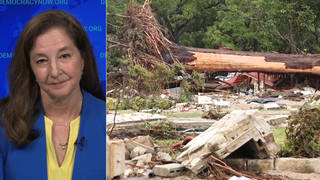
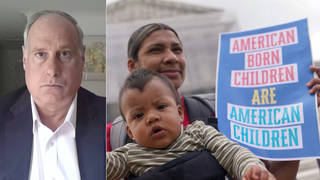
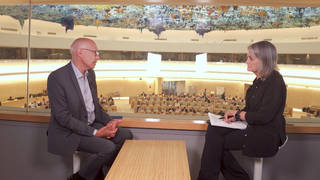
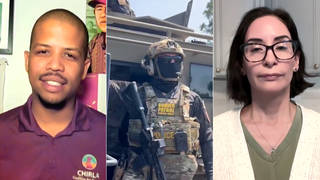
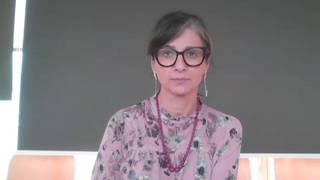
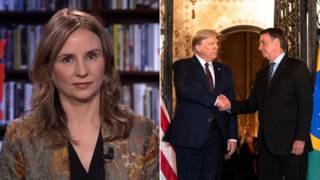
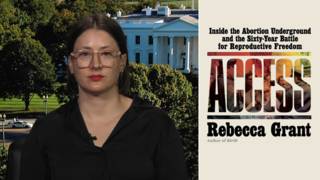

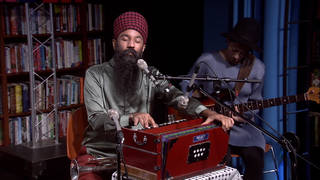

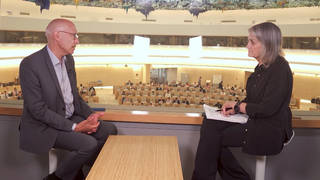
Media Options